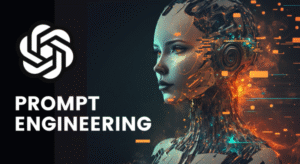“Prompt engineering mastery is key to unlocking AI potential.
A few years ago, if you had told me that one of the most important skills of the next decade would be knowing how to talk to machines, I might’ve laughed. Not because I didn’t believe in AI—but because the idea seemed so… abstract. After all, computers didn’t need coaxing. They followed commands. Inputs. Code.
But everything changed the day I typed my first real prompt into GPT-3.
It wasn’t anything special—just a simple query: “Write a story about a child who finds a spaceship in their backyard.” What came back wasn’t just a paragraph—it was a compelling narrative, with structure, pacing, and even emotional tone. It didn’t feel like autocomplete. It felt like collaboration.
That was the moment I realized: this isn’t just artificial intelligence. This is a new form of creativity—and if I wanted to work with it, I’d need to learn its language.
What Is Prompt Engineering and Why It Matters?
At its core, prompt engineering is the craft of communicating effectively with AI. It’s about asking the right questions, in the right way, to get the results you want. But that definition barely scratches the surface.
In practice, prompt engineering is part psychology, part design, part programming, and part storytelling. You’re not just issuing commands. You’re guiding behavior. You’re shaping outcomes. You’re literally teaching machines how to think like you—without writing a single line of code.
It’s the closest I’ve ever come to mind reading—and being read.
The Learning Curve
My early these were clumsy. I’d ask something vague and get vague results. I’d try to generate business ideas and end up with generic fluff. But slowly, through trial and error, I learned.
I learned that specificity is power.
That context matters.
That the way you frame a request can mean the difference between brilliance and nonsense.
For example:
Give me marketing ideas for my startup.”
“You’re a senior marketing strategist. I run a startup focused on eco-friendly packaging for small e-commerce brands. Give me five creative, low-budget campaigns that could generate buzz in Q4.”
That tiny shift—from a simple ask to a scenario-based prompt—unlocked an entirely new level of value.
I started experimenting:
Prompting AI to simulate investors for pitch practice.
Asking for feedback on scripts and stories from the POV of a Hollywood producer.
Using chain-of-thought prompts to debug my own reasoning, not just the AI’s.
The more I used it, the more I saw the real power wasn’t in the model—it was in me knowing how to speak to it.
Why It Matters Now
We’re living in a moment where AI is no longer theoretical. It’s not just something researchers play with in labs. It’s here—in our browsers, apps, emails, content tools, and classrooms.
Prompt engineering is the key that unlocks all of it.
It’s what lets a filmmaker storyboard a scene in seconds.
It’s what lets a marketer generate 50 email variations in the tone of Hemingway.
It’s what lets a teacher personalize lessons for each student instantly.
And in the corporate world, where productivity, automation, and insight are everything? It’s becoming a competitive advantage.
The Emergence of a New Role
Today, companies are hiring Prompt Engineers the way they once hired web developers in the ’90s. Some are paying six figures or more for people who know how to design interactions between humans and machines.
But even if your title doesn’t include “prompt,” this is a skill worth learning. Why?
Because soon, everyone will be working alongside AI in some capacity. Whether you’re a journalist or a lawyer, a coder or a chef, your ability to shape how machines assist you will define your effectiveness.
It’s not science fiction. It’s the new literacy.
It’s Not Just About Getting Better Outputs—It’s About Thinking Differently
What surprised me most in this journey was how prompting changed me.
I started asking better questions—not just of the AI, but of myself.
I became more intentional, more curious, more iterative in my thinking.
I learned to pause before I typed—to imagine the outcome, reverse-engineer the path, and test my assumptions.
Prompting taught me to think like a systems designer, a psychologist, a storyteller—all at once.
And maybe most importantly, it reminded me that technology is not about replacement. It’s about amplification. When used right, AI doesn’t make you less human. It makes you more capable as one.
The Ethical Layer
Of course, with great power comes great complexity. A poorly constructed prompt can spread misinformation. A biased prompt can reinforce harmful narratives. A manipulative prompt can deceive.
As prompt engineers—or simply users—we hold responsibility. Not just for what AI says, but for how we guide it. That means being aware of our language, our assumptions, and the broader impact of the tools we build and use.
It means prompting with conscience, not just with cleverness.
What’s Next?
We’re only at the beginning.
As models grow more sophisticated, prompt engineering will evolve too. We’ll have prompt toolkits, prompt libraries, and even AI models that prompt other AIs. But no matter how much technology changes, the essence will remain:
Human insight. Human intent. Human creativity.
That’s what makes prompting such a beautiful practice. It’s where logic meets language. Where art meets automation. Where the future is not dictated by code, but crafted through conversation.
If you’ve never tried prompting an AI, start today. Not because it’s trendy, but because it’s transformational.
Start simple. Be specific. Play.
And don’t be afraid to talk to the machine like it’s your most curious intern or your most brilliant co-pilot.

You’ll be surprised at what happens—not just on the screen, but in your mind.
You might enjoy listening to AI World Deep Dive Podcast:
